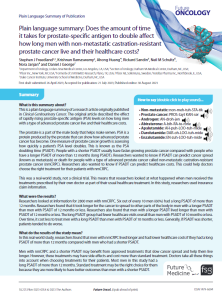A plain language summary describing the effect of rapidly rising prostate-specific antigen (PSA) levels on how long men with a type of advanced prostate cancer live and their healthcare costs
 This Plain Language Summary of Publication article from Future Oncology describes a real-world study describing the effect of rapidly rising prostate-specific antigen (PSA) levels on how long men with a type of advanced prostate cancer live and their healthcare costs.
This Plain Language Summary of Publication article from Future Oncology describes a real-world study describing the effect of rapidly rising prostate-specific antigen (PSA) levels on how long men with a type of advanced prostate cancer live and their healthcare costs.
Please visit Future Medicine using the link to read the full article.
The original article on which this summary is based is called ‘Survival and Economic Impact of Rapid Prostate-Specific Antigen Doubling Time in Patients With Nonmetastatic Castration-Resistant Prostate Cancer’. It was published in Clinical Genitourinary Cancer.
Please visit Clinical Genitourinary Cancer using the link to read the full article.
